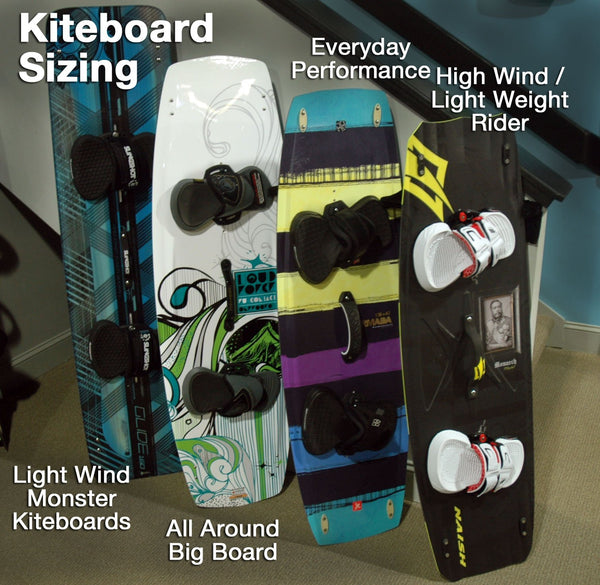What is the best size kiteboard to ride as a beginner?
Generally speaking, your first kiteboard should be easy to ride and a little over your ability level. During your lessons you will be using very big beginner boards or light wind boards. The larger the board, the less power you need in the kite, so your first few rides will be on a monster board and a underpowered kite. Once you can get up and ride both directions you will progress off the big board.
Kiteboarding board design is constantly changing but here is REAL’s take on the different board categories available:

– Light Wind Monster Kiteboards: 150cm-170cm
These boards tend to be really flat, wide, and have almost no rocker(amount of bend in the board from tip to tip). The massive amount of surface area allows you to drive upwind in the light stuff, and these boards will get a little bouncy in the chop.
– All Around Big Board: 140cm-150cmTo make an all around big board work it has to be really easy to ride and versatile for all types of conditions. Widths can vary in this category. The wider the board the better it will do in light wind and the narrower the board the better it will do in chop. These boards usually have a little more rocker than the light wind monster boards.
– Every Day Performance Kiteboard: 135cm-142cm
If you think about the perfect conditions and the perfect board to match you will land in this category. Often times this board will be a bit above your ability level when you first start out but you will grow into it during your first few sessions.
– High Wind/Light Weight Rider: 126cm-135cm
With really high winds you will have a lot of chop. A smaller board with less surface area can sink into the water more providing you with more control in high winds. Lighter riders will have the same results of easier edging with this category.
Most people will fit into the All Around Big Board or Every Day Performance categories for their first kiteboard.
In order to decide between these two options, try asking yourself these questions:
1. How much do you weigh?
Weight will really change how the board reacts. Very simply put, the larger the rider, the bigger the board and vice versa.
2. What types of wind speed do you get at your local kite beach?
The optimal winds for learning to kiteboard are 12-25mph. Many beaches will get in the 14-18mph pretty regularly and in those conditions kiteboarding is easy. If you are in higher winds you can size your board down and in lighter winds you can size your board up.
3. Do you have any board skills?
If you are a strong surfer, wakeboarder or snowboarder, you can jump down a size and “grow into” your kiteboard quickly. This will insure that you don’t grow need to replace your board after the first few months. For those that don’t have any board skills you will want to get a really easy to ride board that is bigger than average to make up for the lack of board skills.
Still confused? Here are a few case studies that have come through the door at REAL.
-Karl, 185lbs, No previous board skills, Kiting in the San Fransisco Bay, CA (15-25mph):
After Karl took some lessons and got riding one direction he bought his first quiver of kites and his first kiteboard. We put him into the All Around Big Board category and he got a wide 142cm board that had enough rocker to cut through the chop. Once he got better at kiteboarding, this became his light wind board and he ended up on a 136cm board in the Every Day Performance category.
-Victoria, 125lbs, Some snowboarding skills, Kiting in Boston, MA(13-22mph):
She really wanted to take her time and enjoy the process. She had a bad experience being overpowered right at the beginning, so she wanted to ride the kites underpowered at first. We got her a 137 in the Every Day Performance category. This was a little bigger for her size, so she could ride her kites underpowered. As she got better at kiteboarding, this board size grew with her because it was a performance-oriented board.
-Sam, 220, Lots of wakeboarding, Kiting in Jupiter, FL(12-20mph):
Since Sam was a big guy riding in a predominantly light wind area we needed to get him a board in the All Around Big Board category. He got a wide 145cm board that had a flatter rocker line. This gave his board good drive upwind and had enough planing surface to get him going in the light stuff. When the wind comes up he can still ride aggressively on this board because he is a bigger guy.
If you have any questions or need help and advice: contact a REAL Pro.

